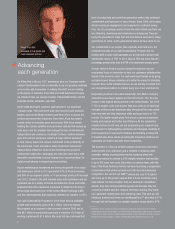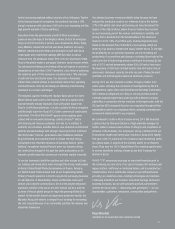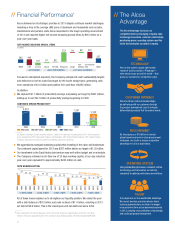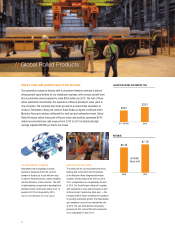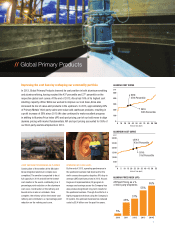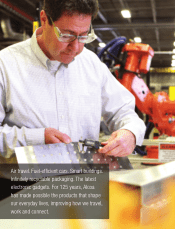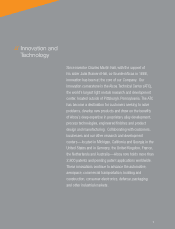Alcoa 2013 Annual Report Download - page 13
Download and view the complete annual report
Please find page 13 of the 2013 Alcoa annual report below. You can navigate through the pages in the report by either clicking on the pages listed below, or by using the keyword search tool below to find specific information within the annual report.
Constructing hurricane-strong
building materials
As severe weather patterns have increased
across North America, so too has the need
for buildings that can resist the impact of
hurricanes. Building codes requiring this
type of durability have moved both inland
and up the coast of the United States, from
Florida—where hurricanes have been the
norm for many years—now to the country’s
northeastern states. These tougher building
codes are growing significantly faster than
the overall construction market.
To meet these needs and capture growing
demand, Alcoa has developed the broadest
offering of high-thermal, blast mitigating
products in the industry. An example
is the IR501UT framing system, which,
compared to Alcoa’s standard framing
systems, provides a 54% improvement
in thermal performance and a 60%
improvement in structural performance
and glass retention.
In addition, Alcoa developed an innovative
hurricane impact solution called 1630SS
IR Curtain Wall, which meets the growing
need across the United States for buildings
that can stand up against storms such
as Hurricane Sandy. With the ability to
withstand object impacts of over 50
miles per hour, this product meets the
most demanding building performance
standard, “Level E,” which is given to
products that can protect buildings and
the people inside them.
Photo courtesy of Key Glass LLC
Reinventing the wheel alloy
Alcoa invented the forged aluminum
wheel, and in 2013, rolled out the most
advanced aluminum wheel alloy in 45
years. This new material opens the door
for lighter weight wheels at increased
strength with the same corrosion-resistant
characteristics as the industry standard,
Alcoa’s 6061 alloy. Alcoa expects to
introduce a new, state-of-the-art wheel
featuring the alloy in 2014. The new
lightweight alloy, called MagnaForce™,
is, on average, 17% stronger than the
industry standard in similar applications.
Alcoa will use the material to manufacture
wheels for commercial transportation,
where lighter weight products that
increase fuel efficiency
are in high demand.
Alcoa has been the industry leader since
inventing the forged aluminum wheel in
1948 using an alloy it had developed for
the aerospace industry.
Thinner, lighter,
stronger electronics
Alcoa developed a surface finishing
technology that enables consumer
electronics companies to use aerospace-
grade aluminum to make thinner, lighter
and stronger mobile devices. Alcoa’s new
ProStrength™ Finishing Technology is
a process that allows manufacturers to
design clear or color-anodized surfaces
using high-strength aluminum alloys,
including state-of-the-art aluminum-
lithium alloys, used in the aerospace
and defense industries, which could
reduce the thickness and weight of a
device by more than 50%.
Device size as well as design look and
feel are significant factors for consumers
buying the latest electronics gadgets—
and aluminum provides the durability,
performance and attractiveness that
consumers want. Alcoa continues to
work with the world’s leading electronics
companies and designers to enable the
use of aluminum in mobile devices.
11



